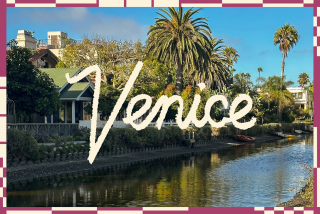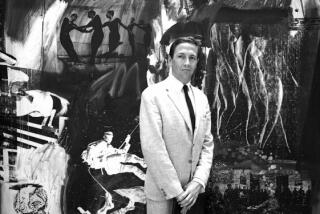NONFICTION - Jan. 12, 1986
- Share via
VENICE II, text by Olivier Bernier, photographs by Fulvio Roiter (Vendome: $45).
VIDAL IN VENICE by Gore Vidal, photographs by Tore Gill (Summit: $22.95).
DETROIT by Dale Fisher (Monkfish, 749 Airport Blvd., Ann Arbor, Mich. 48104: $50).
Theophile Gautier compared its domed skyline to a melody on a chromatic scale; Thomas Mann saw it as a symbol of decadence. More than 12 centuries after its founding, Venice continues to exert a special fascination, as two of these volumes attest. “Venice II” abounds with the kind of artsy color pictures that win photography contests: brightly colored boat hulls drying in the sun, children playing in front of ancient brick walls, tiny details picked out in sharp focus against vast, fuzzy backgrounds. The results showcase Fulvio Roiter’s talent, rather than the city. As the illustrations and the pages aren’t numbered and the captions are, it’s difficult to determine what’s what, and the reader learns very little about Venice. This splashy book is obviously intended for the coffee table, but destined for the publisher’s overstock table. “Vidal in Venice,” designed to go with a two-hour program shown on British television last August, is considerably more informative. Gore Vidal offers a superficial, anecdotal account of the city’s long and curious history. Although more gossipy than scholarly, this book does include such niceties as a bibliography, a map and captions that relate to the illustrations. Reproductions of Venetian paintings supplement Gill’s handsome photographs and contribute to a pleasant diversion for the armchair traveler. A paean to a city more often associated with old Supremes songs than Romantic poetry, “Detroit” looks like the most opulent travel brochure ever assembled. Dale Fisher’s photographs emphasize the gleaming new skyscrapers and avoid the old, soot-begrimed buildings. General Motors commissioned the book, and Chairman Roger Smith calls the city “a place unique in all the world: to some a home, to more a workplace, and to all the capital of America’s gathering industrial revival.” It would be interesting to hear what the approximately 10% of the city’s population that remains unemployed would have to say about the city, the gathering revival--and this book.
More to Read
Sign up for our Book Club newsletter
Get the latest news, events and more from the Los Angeles Times Book Club, and help us get L.A. reading and talking.
You may occasionally receive promotional content from the Los Angeles Times.









